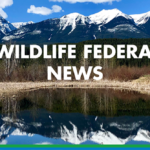Program launched to accelerate conservation of areas around Canada’s National Parks
Habitat loss and climate change threaten the iconic plants and animals that bring our national parks to life.
That’s why Canada’s two largest conservation organizations have partnered to protect landscapes around these natural areas.
At the Ottawa-Carleton Wildlife Centre, the Nature Conservancy of Canada (NCC) and Parks Canada (PC) launched the Landscape Resiliency Program, a $30-million effort to support resilient landscapes by conserving up to 30,000 hectares near national parks, connecting habitats and creating protected buffers around the parks.
NCC president and CEO, Catherine Grenier, made the announcement with the Honourable Steven Guilbeault, Minister of Environment and Climate Change and Minister responsible for Parks Canada.
“This important initiative builds on our longstanding relationship with Parks Canada to address the impacts of the twin crises of climate change and biodiversity loss in Canada,” said Catherine
Grenier, President and CEO, Nature Conservancy of Canada.
“Nature knows no bounds; neither should we.
“That’s why partnerships like this are so critical. NCC will rally its vast network of partners across the country around our evidence-based approach to deliver impactful conservation solutions around some of Canada’s most iconic natural places. Through partnership, expertise and perseverance, we will conserve critical habitat for the plants and animals we cherish, and ecosystem services that benefit all communities.”
NCC will leverage PC’s $15-million investment to raise matching funds to protect buffer zones and wildlife corridors by working with Indigenous Nations, local communities, property owners and other partners. The protected areas will be located near national parks, including:
- Gulf Islands National Park Reserve and Kootenay National Park (British Columbia)
- Waterton Lakes National Park (Alberta)
- Grasslands National Park (Saskatchewan)
- Thousand Islands, Bruce Peninsula and Point Pelee National Parks (Ontario)
- La Mauricie National Park (Quebec)
- Kouchibouguac National Park (New Brunswick)
- Kejimkujik National Park & National Historic Site (Nova Scotia)
NOTE: Additional National Park sites may be added.
These areas will be conserved through a variety of ways, such as land purchases, donations, agreements with landowners and tools such as other effective area-based conservation measures.
Nature knows no bounds
Animals of all sizes need to be able to move freely across landscapes to live, feed, breed and thrive. Large animals like grizzly bears can roam as far as 250 kilometres over the course of a year, following food sources and establishing their territories. Even small animals like endangered Blanding’s turtles will travel great distances in their efforts to find nesting sites.
However, human encroachment and the effects of climate change are shrinking the area of land available for the natural movement of animals in and out of our national parks.
By protecting lands near national parks, this partnership will expand and connect protected and conserved areas for many of Canada’s most emblematic species.
Parks and protected areas can protect a range of values, including species at risk, representativity, ecological connectivity and climate connectivity. The areas targeted through the Landscape Resiliency Program include some of the most treasured places in Canada where conservation action is urgently needed to halt biodiversity loss and ensure long-term ecological health.
As Canada’s largest non-profit conservation organization, NCC works at the scale and scope needed to achieve the goals of this partnership. Backed by its more than 60-year track record of finding tailored conservation solutions across the country, NCC will deploy innovative technology to identify priority areas for conservation around national parks. The organization will also work with donors, partners, Indigenous Nations and local communities to ensure their protection.
Protecting nature around parks secures critical habitats and natural features that act as carbon sinks, water storage and filtration systems and air purifiers, all of which also support communities’ well-being.
NCC already works with a variety of partners to care for more than 63,000 hectares of conserved lands near to 24 national parks in Canada. The organization will now leverage this new partnership to grow these areas.
Connecting already-protected lands with national parks will ensure nature-based solutions and critical ecosystems remain intact for the long term, for mthe benefit of those who rely on them — plants, animals and people alike.
This partnership will advance NCC’s commitment to be an ally and partner with Indigenous Nations and communities, and to support Indigenous-led conservation efforts.
NCC is mobilizing support across all sectors — private citizens, Indigenous Nations and communities, landowners, businesses, foundations and all levels of government — to leverage the $15-million Parks Canada investment and maximize impact. Only by having everyone at the table can we find solutions to address climate change and rapid biodiversity loss.


























Comments